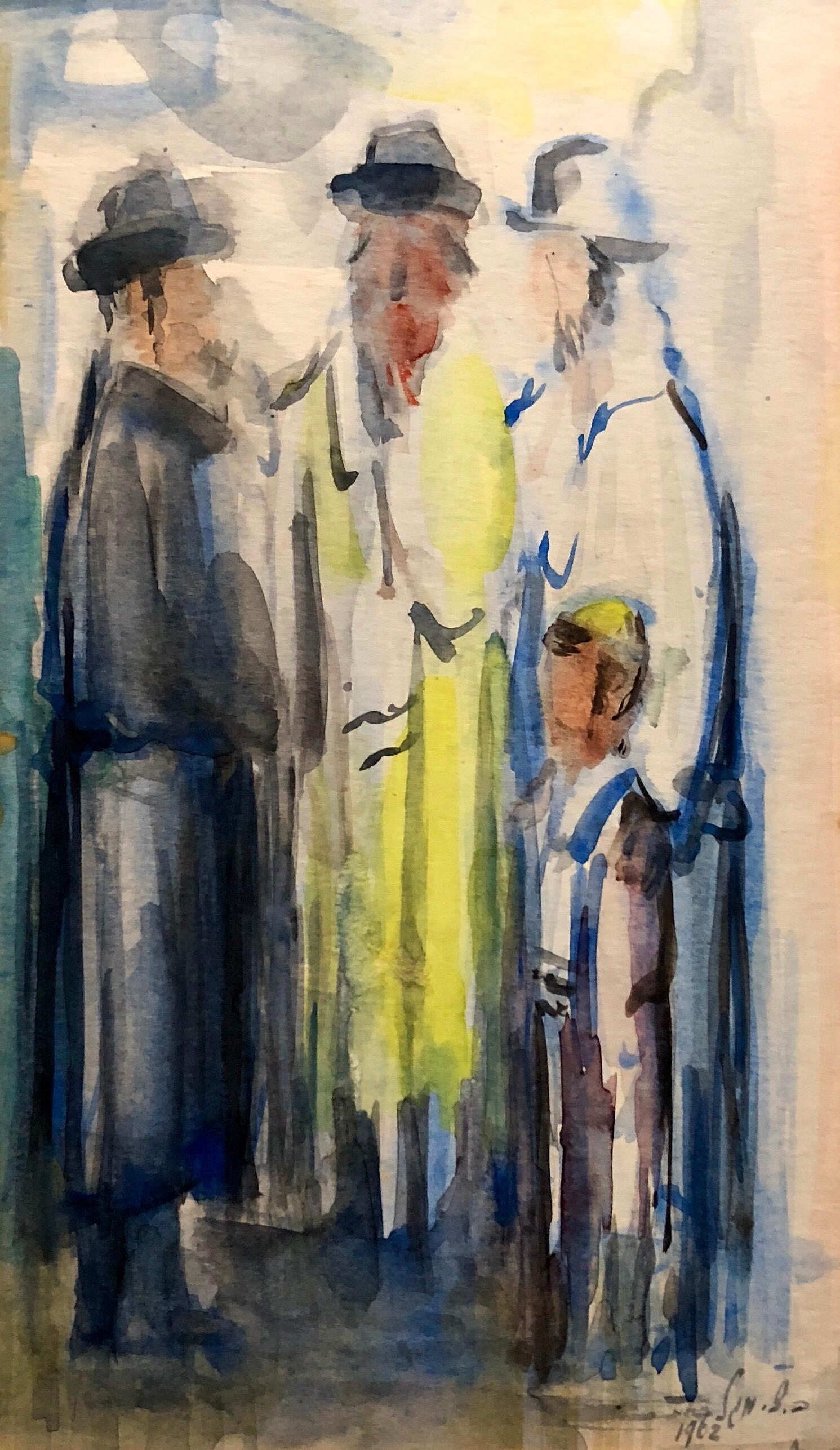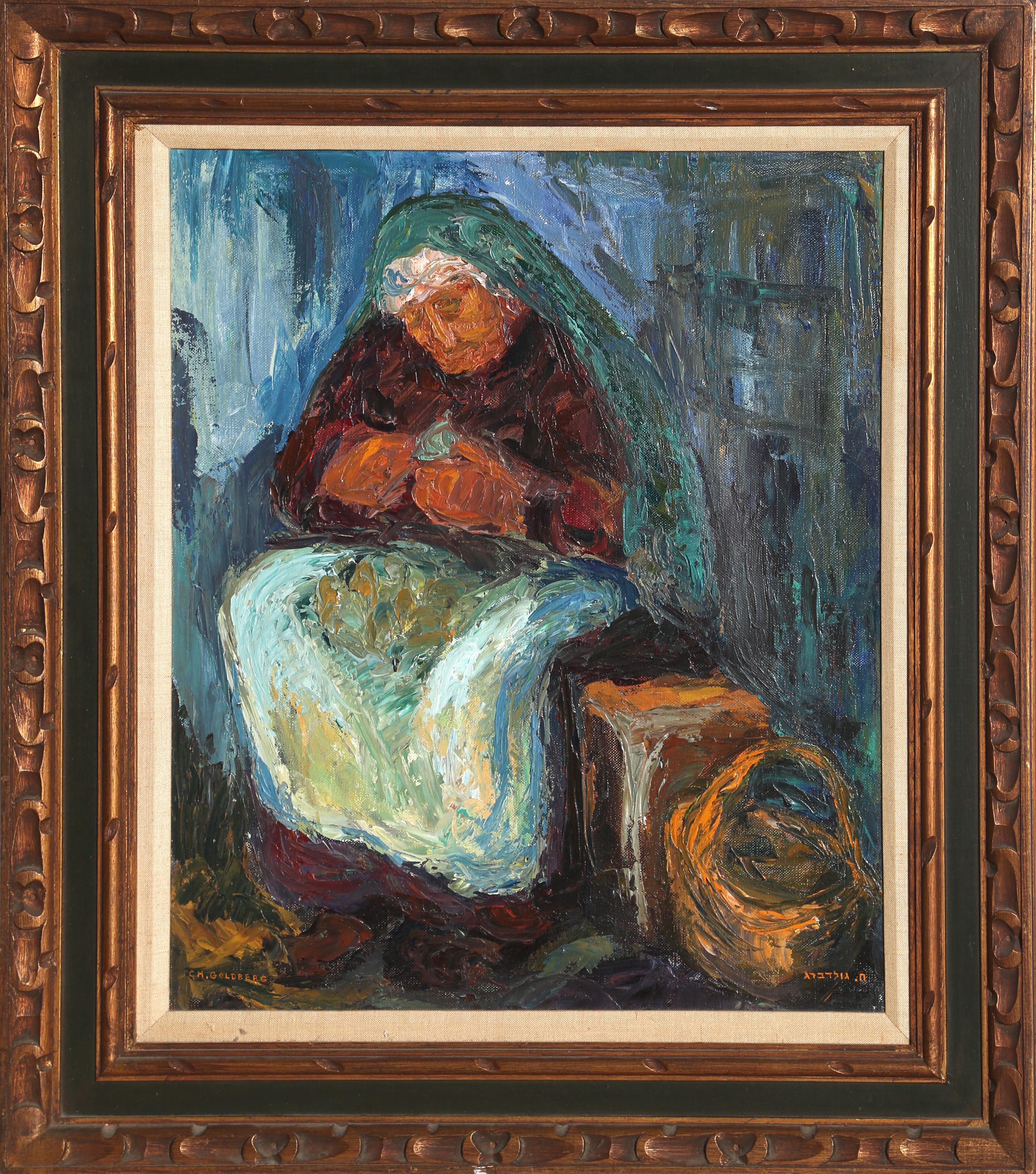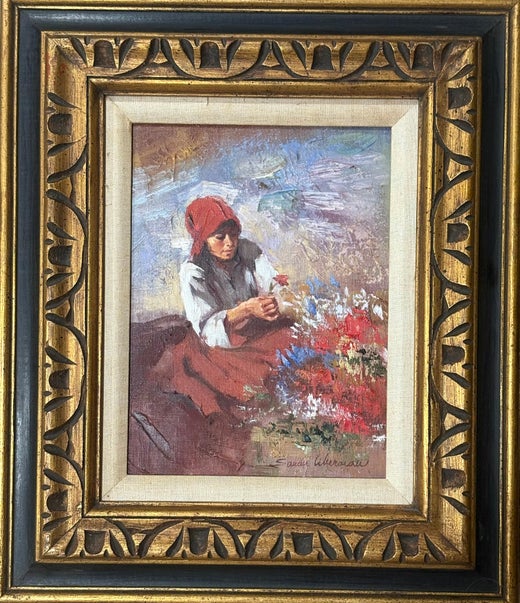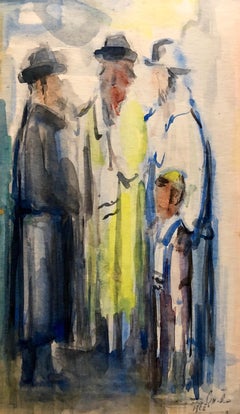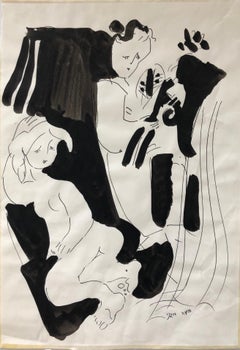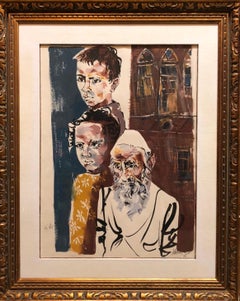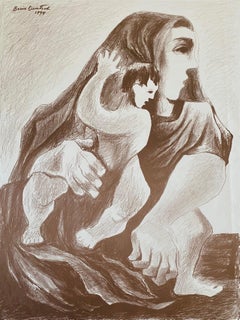Items Similar to Large Gouache Original Painting Mother & Daughter Sandu Liberman Israeli Judaica
Want more images or videos?
Request additional images or videos from the seller
1 of 11
Sandu LibermanLarge Gouache Original Painting Mother & Daughter Sandu Liberman Israeli Judaica
$950
£721.22
€824.93
CA$1,327.29
A$1,476.23
CHF 770.84
MX$17,964.19
NOK 9,844.85
SEK 9,232.73
DKK 6,156.74
Shipping
Retrieving quote...The 1stDibs Promise:
Authenticity Guarantee,
Money-Back Guarantee,
24-Hour Cancellation
About the Item
framed 36 X 28 board 30 X 21.75
Sandu Liberman (Romanian-Israeli) was born in Yasi, Romania in 1923. between 1946 and 1953 he took part in the state art shows in Bucharest. in 1952 he was awarded the gold medal at the International Art Festival in Romania. that same year he was commissioned to illustrate the large encyclopedia Rumania, and was appointed Official Portrait Artist of Romania. He went to Israel in 1962 and settled there. Liberman was commissioned by the Government of Israel to make portraits on many occasions. He was a contemporary of William Weintraub and known for his realist illustration art style similar to the magazine illustrator and romance novel cover art popular at the time. Known for his depictions of Israeli dancers, city life, Polish Hassidic Rabbis, Yemenite Jews, Jerusalem and Judaica scenes and nudes.His portraits often feature women in prayer framed by votive candles. Settling in Israel in 1962, he received many commissions from the Israeli Government to paint portraits of high-ranking officials. The artist died in 1977.
He is in the collection of th Smithsonian Institution amongst others.
- Creator:Sandu Liberman (1923-1977, Romanian)
- Dimensions:Height: 36 in (91.44 cm)Width: 28 in (71.12 cm)
- Medium:
- Movement & Style:
- Period:
- Condition:sight size is 23.5X17.5 will be sold matted. unframed as it needs new frame.
- Gallery Location:Surfside, FL
- Reference Number:1stDibs: LU38213365992
Sandu Liberman
Sandu Liberman was born in Yasi, Romania in 1923. Between 1946 and 1953 he took part in eleven state shows in Bucharest. In 1952 he was awarded the gold medal at the International Art Festival in Romania. That same year he was commissioned to illustrate the large encyclopedia Romania, and was appointed Official Portrait Artist of Romania. He went to Israel in 1962 and settled there. Liberman was commissioned by the Government of Israel to make portraits on many occasions. In 1965 he was commissioned by the Government of Israel to make a portrait of the President of Guinea and it hangs in the Royal Palace. Liberman died in 1977
About the Seller
4.9
Platinum Seller
Premium sellers with a 4.7+ rating and 24-hour response times
Established in 1995
1stDibs seller since 2014
1,784 sales on 1stDibs
Typical response time: <1 hour
- ShippingRetrieving quote...Shipping from: Surfside, FL
- Return Policy
Authenticity Guarantee
In the unlikely event there’s an issue with an item’s authenticity, contact us within 1 year for a full refund. DetailsMoney-Back Guarantee
If your item is not as described, is damaged in transit, or does not arrive, contact us within 7 days for a full refund. Details24-Hour Cancellation
You have a 24-hour grace period in which to reconsider your purchase, with no questions asked.Vetted Professional Sellers
Our world-class sellers must adhere to strict standards for service and quality, maintaining the integrity of our listings.Price-Match Guarantee
If you find that a seller listed the same item for a lower price elsewhere, we’ll match it.Trusted Global Delivery
Our best-in-class carrier network provides specialized shipping options worldwide, including custom delivery.More From This Seller
View AllIsraeli Judaica Watercolor Gouache Bar Mitzvah Boy Rabbi Painting Russian Artist
By Ben Zion Magal
Located in Surfside, FL
Ben Zion Magal (1908 - 1999)
Ben Zion Magal was born in 1908 in Kishinev - Russia and there, years later, graduated from the Art Academy. He arrived to Erertz Israel together with hi...
Category
1960s Neo-Expressionist Figurative Paintings
Materials
Watercolor, Gouache
Vintage Israel Bezalel School Watercolor Painting Artist with Model Kibbutz Life
By Moshe Avni
Located in Surfside, FL
Moshe Avni was born in 1937, in Kibbutz Kfar Blum in the Upper Galilee in Israel. Presently, he lives and paints in Jerusalem. During the years 1956-1957, he studied Painting and Gra...
Category
1960s Modern Figurative Drawings and Watercolors
Materials
Watercolor, Pen
Large Watercolor Painting Israeli Modernist Judaica Rabbi with Children, Bezalel
By Moshe Gat
Located in Surfside, FL
A large watercolor painting.
Moshe Gat was born in Haifa in 1935.
in 1952 he began his studies at the Bezalel School, in Jerusalem.
In 1955 he returned to Haifa, where he taught dra...
Category
Mid-20th Century Expressionist Figurative Drawings and Watercolors
Materials
Paper, Watercolor
Lithuanian Artist Colored Lithograph Mother And Son - Boris Deutsch
By Boris Deutsch
Located in Surfside, FL
Boris deutsch was born in krasnagorka lithuania june 4 1892 died in los angeles 1978.Entered the polytechnic school in riga 1905.School of applied arts berlin 1912. Settled in l.A. 1...
Category
20th Century Modern Figurative Prints
Materials
Etching
Simka Simkhovitch WPA Artist Oil Painting Family Mother, Kids American Modernist
By Simka Simkhovitch
Located in Surfside, FL
Simka Simkhovitch (Russian/American 1893 - 1949)
This came with a small grouping from the artist's family, some were hand signed some were not.
These were studies for larger paintings.
Simka Simkhovitch (Симха Файбусович Симхович) (aka Simka Faibusovich Simkhovich) (Novozybkov, Russia May 21, 1885 O.S./June 2, 1885 N.S.—Greenwich, Connecticut February 25, 1949) was a Ukrainian-Russian Jewish artist and immigrant to the United States. He painted theater scenery in his early career and then had several showings in galleries in New York City. Winning Works Progress Administration (WPA) commissions in the 1930s, he completed murals for the post offices in Jackson, Mississippi and Beaufort, North Carolina. His works are in the permanent collections of the Dallas Museum of Art, the National Museum of American Art and the Whitney Museum of American Art. Born outside Kyiv (Petrograd Ukraine) into a Jewish family who owned a small department store. During a severe case of measles when he was seven, Simcha Simchovitch sketched the views outside his window and decided to become an artist, over his father's objections. Beginning in 1905, he studied at the Grekov Odessa Art School and upon completion of his studies in 1911 received a recommendation to be admitted to the Imperial Academy of Arts. Though he enrolled to begin classes in architecture, painting, and sculpture at the Imperial Academy, he was dropped from the school roster in December because of the quota on the number of Jewish students and drafted into the army. Simchovitch served as a private in the 175th Infantry Regiment Baturyn [ru] until his demobilization in 1912. Re-enrolling in the Imperial Academy, he audited classes.
Simka Simkhovitch exhibited paintings and sculptures in 1918 as part of an exhibition of Jewish artists and in 1919 placed 1st in the competition "The Great Russian Revolution" with a painting called "Russian Revolution" which was hung in the State Museum of Revolution. In 1922, Simkha Simkhovitch exhibited at the International Book Fair in Florence (Italian: Fiera Internazionale del Libro di Firenze). In 1924, Simkhovitch came to the United States to make illustrations for Soviet textbooks and decided to immigrate instead. Initially he supported himself by doing commercial art and a few portrait commissions. In 1927, he was hired to paint a screen for a scene in the play "The Command to Love" by Fritz Gottwald and Rudolph Lothar which was playing at the Longacre Theatre on Broadway. Art dealers began clamoring for the screen and Simkhovitch began a career as a screen painter for the theater. Catching the attention of the screenwriter, Ernest Pascal, he worked as an illustrator for Pascal, who then introduced him to gallery owner, Marie Sterner. Simkhovitch's works appeared at the Marie Sterner Gallery beginning with a 1927 exhibit and were repeated the following year. Simkhovitch had an exhibit in 1929 at Sterner's on circus paintings. In 1931, he held a showing of works at the Helen Hackett Gallery, in New York City and later that same year he was one of the featured artists of a special exhibit in San Francisco at the California Palace of the Legion of Honor in Lincoln Park. The exhibit was coordinated by Marie Sterner and included four watercolors, including one titled "Nudes". He is of the generation of Russian Soviet artists such as Isaac Pailes, Serge Charchoune, Marc Chagall, Chana Orloff, Isaac Ilyich Levitan, and Ossip Zadkine.
In 1936, Simkhovitch was selected to complete the mural for the WPA Post office project in Jackson, Mississippi. The mural was hung in the post office and courthouse in 1938 depicted a plantation theme. Painted on the wall behind the judge’s bench, “Pursuits of Life in Mississippi”, a depiction of black workers engaged in manual labor amid scenes of white professionals and socialites, was eventually covered over in later years during renovations due to its stereotypical African American imagery. The following year, his painting "Holiday" won praise at an exhibition in Lincoln, Nebraska. In 1940, Simkhovitch's second WPA post office project was completed when four murals, "The Cape Lookout Lighthouse and the Orville W. Mail Boat", "The Wreck of the Crissie Wright", "Sand Ponies" and "Canada Geese" were installed in Beaufort, North Carolina. The works were commissioned in 1938 and did not generate the controversy that the Jackson mural had. The main mural is "The Wreck of the Crissie Wright" and depicts a shipwreck which had occurred in Beaufort in 1866. "The Cape Lookout Lighthouse and the Orville W. Mail Boat" depicted the lighthouse built in 1859 and the mail boat that was running mail during the time which Simkhovitch was there. The boat ran mail for the area until 1957. "Sand Ponies" shows the wild horses common to the North Carolina barrier islands and "Canada Geese" showed the importance of hunting and fishing in the area. All four murals were restored in the 1990s by Elisabeth Speight, daughter of two other WPA muralists, Francis Speight...
Category
1930s American Modern Figurative Paintings
Materials
Oil, Board
Family, Mother, Children, Modernist Israeli Oil Painting Aharon Giladi
By Aharon Giladi
Located in Surfside, FL
Aharon Giladi was born in 1907 in Russia. He studied in Leningrad and in 1929 came to Israel, where he was until 1949 a member of a kibbutz in the Jordan Valley.
His dynamic line...
Category
Mid-20th Century Modern Figurative Paintings
Materials
Oil
You May Also Like
Mother and Daughter, Oil Painting by Sandu Liberman
By Sandu Liberman
Located in Long Island City, NY
Artist: Sandu Liberman, Romanian/Israeli (1923 - 1977)
Title: Mother and Daughter
Year: Circa 1970
Medium: Oil on Canvas, signed l.r.
Size: 36 x 24 in. (91.44 x 60.96 cm)
Frame Size:...
Category
1970s Expressionist Figurative Paintings
Materials
Oil
Sisters, Modern Oil Painting by Sandu Liberman
By Sandu Liberman
Located in Long Island City, NY
Artist: Sandu Liberman, Romanian/American (1923 - 1977)
Title: Sisters
Year: circa 1970
Medium: Oil on Canvas, signed l.r.
Size: 36 in. x 24 in. (91.44 cm x 60.96 cm)
Frame Size: 44....
Category
1970s American Modern Portrait Paintings
Materials
Canvas, Oil
Edna Hibel Mother and Child Original Oil Painting on Silk
By Edna Hibel
Located in San Francisco, CA
Edna Hibel: 1917-2015. Well listed important American artist. Mostly associated with Florida and Massachusetts. There is a Hibel Museum in Florida. Some called her the latter 20th ce...
Category
1960s Figurative Paintings
Materials
Oil
Mother and Child Oil Painting 1968
Located in Douglas Manor, NY
3790 American Impressionist oil on canvas
Image size 19.5x15.5
Category
1960s Figurative Paintings
Materials
Oil
Mother, Oil Painting by Chaim Goldberg
Located in Long Island City, NY
Artist: Chaim Goldberg, Israeli (1917-2004)
Title: Mother
Medium: Oil on Canvas, signed in English lower left and Hebrew lower right
Size: 24 x 20 inche...
Category
1970s Expressionist Portrait Paintings
Materials
Oil, Canvas
Vintage American Modern Oil Painting Mother and Daughter by MT Braley
Located in Douglas Manor, NY
5166 Vintage American modernist oil on canvas of a mother and daughter
Category
1970s Figurative Paintings
Materials
Oil
$760 Sale Price
20% Off
More Ways To Browse
Mother Daughter
Jew Painting
Modern Judaica Painting
Romance Was Born
Israeli Women
Nude Daughter
Romance Cover Art
Nude Israel
Rabbi Painting Portrait
Framed Rabbi
Jerusalem City Of Gold
Judaica Rabbi Portrait
Judaica Candle
Vintage Candle Votives
Rabbis Dancing
Dancing Rabbis Painting
Romanian Painter
Judge Portrait
